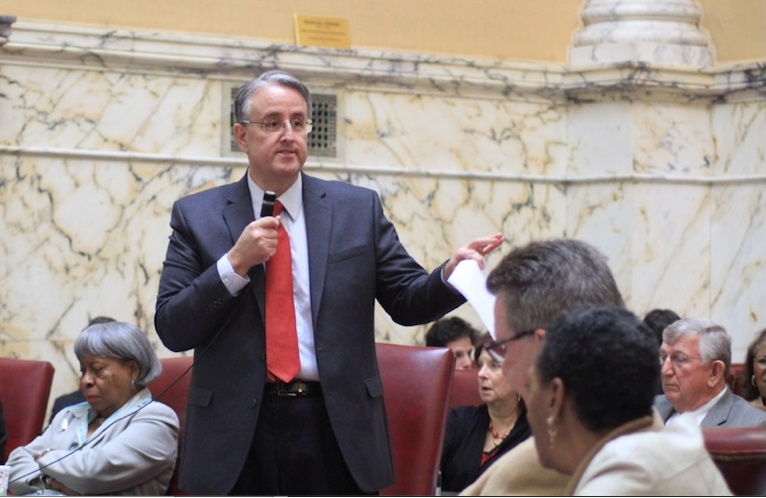By Megan Poinski
Megan@MarylandReporter.com
Several Maryland state government agencies are discovering that there’s a lot to “like” on Facebook.
The social networking site, which boasts more than 500 million users worldwide, is free; offers an easy way to share information, videos and pictures; and is becoming a social necessity for anyone with a computer.
About a year ago, Department of Human Resources Communications Director Nancy Lineman started to see possibilities for her agency on Facebook. She created a page for the department to share news, pictures, videos and events. Today, 454 people “like” the Maryland Department of Human Resources, and receive constant updates from the agency on their Facebook homepages.
“The reason we started doing it is that a lot of 20- to 55-year-olds are using this connection,” Lineman said. “I figured we could also be using it to put our stuff out there.”
The Department of Human Resources – as well as at least nine other departments, and several independent state government instrumentalities – looks at its Facebook page as a vital connection to people that the department serves, the general public, and policymakers.
Why Facebook?
Lineman and another staff member keep their eyes open for things to add to the department of Human Resources’ Facebook page. The social networking site offers an easy platform to share agency news and statistics – but in a format that people can understand. It also helps the department get some of its initiatives across.
During the week of Thanksgiving, the department had two postings about things it was thankful for: Foster parents, adoptive parents, and timely child support payments; and its staff that serves about 700,000 Marylanders in need. The department’s current status asks users if they are helping a needy family this holiday.
“It’s definitely helpful for information sharing,” Lineman said. “It’s free, it’s not very time-consuming, we can put the link on our homepage, and it’s another way to connect with the people we serve.”
The Maryland Department of Planning took its first foray into Facebook almost a year ago, prior to the start of the PlanMaryland project, said John Coleman, the public information officer. PlanMaryland is the state’s sustainable development initiative, and it was vital to be able to get interactive information out to people, Coleman said.
The Department of Planning has been refocusing its social media strategy for the last month and a half, Coleman said. The goal is to engage with people through many channels. Four people contribute to the pages the department operates – PlanMaryland, the Department of Planning, and the Maryland Planning Commissioners Association. The pages are filled with links to articles about development – in Maryland and out of state.
The Maryland State Department of Education just got on Facebook about three months ago. William Reinhard, a department spokesman, said that they had been thinking about starting a page since the beginning of the year.
“It seemed like that’s where a number of young parents are going and getting a lot of their information,” Reinhard said. “The key in any organization is that you go where your clients are.”
The Maryland State Police, on the other hand, got on Facebook somewhat unintentionally, said Sgt. Julio Valcarcel, one of the page’s three moderators. About three months ago, he noticed that there were other pages that were purporting to be from the department – but featuring inappropriate content. Valcarcel said that the department couldn’t do anything about those pages, but it could start an official page for its own message.
“This is another way for us to get the word out,” Valcarcel said. “It’s community outreach, the way I see it.”
By its own policies, the State Police has a conservative philosophy when it comes to putting information out. The Facebook page has a very specific strategy, Valcarcel said. It is not a mechanism for delivering news about the department – which mostly has to do with crime and law enforcement initiatives.
The page talks about the department’s community service initiatives and new laws concerning motorists. It has created “events” for its annual winter fundraisers, so people can get more information about them. However, most posts on the page are memorials to troopers who were killed in the line of duty – going back to the inception of the department in 1935. On the anniversary of a trooper’s death, his or her photo and a short biography are posted. Valcarcel said those memorials have driven quite a bit of interaction from people who knew the troopers.
The State Police’s recruiting office and aviation command also have their own Facebook pages.
Getting the message out
There may be 500 million people on Facebook, but that doesn’t mean people will be able to easily find information an organization puts up. Most state agencies have only a couple hundred people who “like” them – unlike Gov. Martin O’Malley, who is “liked” by 35,276 people on Facebook.
Since becoming re-engaged in social networking a couple months ago, the Planning Department is trying to build its followers. PlanMaryland has 253 people who “like” it, compared with 108 for the Maryland Planning Department, and 11 for the Maryland Planning Commissioners Association.
The State Education Department, with 128 people who “like” it, is moving slowly to learn how to best use the social networking site, Reinhard said. It hasn’t done much promotion yet. So far, the site is a clearinghouse for information on education in general and in Maryland, featuring links to articles about projects and studies dealing with education. Reinhard and one other person on the academic policy staff update the Facebook page, and strive to have three to four new posts a week.
Valcarcel said that he has not promoted the State Police’s page, but there hasn’t been a need yet. The page has 530 people who “like” it.
“It’s there, and people have found us,” he said.
Problems
Most agencies have easily adopted Facebook, and have had no negative repercussions. They have faced a couple minor problems, but they were easily addressed.
At the Human Resources Department, Lineman said that a couple of inappropriate comments have been placed on the page’s public wall – making personal comments and talking about specific people who are not paying child support. Lineman said the site is moderated at least twice a day, and any comments like that are automatically deleted. Human Resources employees then directly contact the people who posted the comments to help them solve their problems.
Coleman said that the Planning Department made a mistake when it first created the PlanMaryland page early this year. It was set up as a Facebook personal page – meant for individuals to connect with “friends” and retain privacy. A new PlanMaryland page has been created as a Facebook business page, which allows for more open access.
“We had over 600 friends on the first page,” Coleman said.
Coleman said that Facebook is easy to use, but he wishes people would use it to interact with the department more. He has heard several comments in conversations about the department’s presence on social media, but the Facebook page is relatively silent.
“I’d like people to start ‘liking’ our posts,” he said. “Unless people ‘like’ what you post, you don’t know how good you are doing.”





Recent Comments